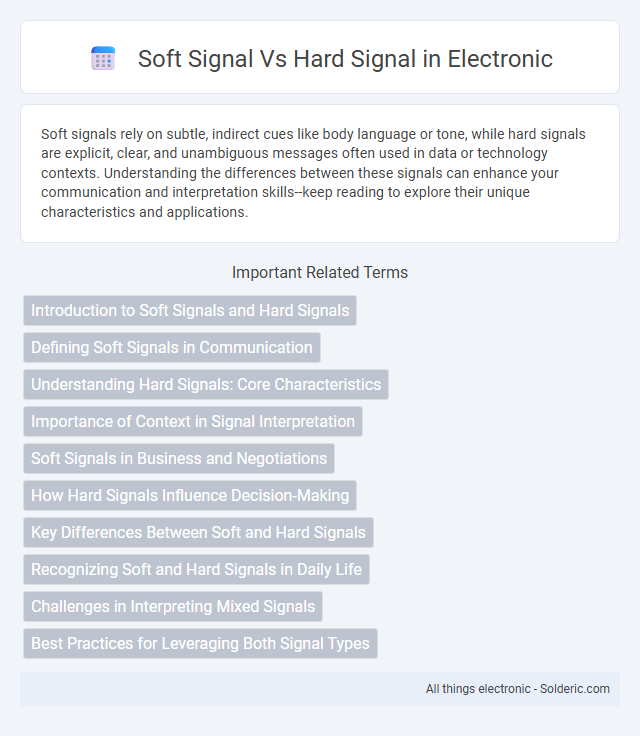Soft signals rely on subtle, indirect cues like body language or tone, while hard signals are explicit, clear, and unambiguous messages often used in data or technology contexts. Understanding the differences between these signals can enhance your communication and interpretation skills--keep reading to explore their unique characteristics and applications.
Comparison Table
| Aspect | Soft Signal | Hard Signal |
|---|---|---|
| Definition | Subtle, indirect indicators or hints. | Clear, direct, and measurable indicators. |
| Nature | Qualitative, interpretative. | Quantitative, objective. |
| Examples | Customer sentiments, market rumors, user feedback. | Sales data, website traffic, conversion rates. |
| Reliability | Less reliable due to subjectivity. | Highly reliable due to factual basis. |
| Usage | Used for early detection and trend spotting. | Used for performance measurement and decision validation. |
| Data Source | Unstructured data like conversations, social media. | Structured data like databases, analytics tools. |
| Analysis | Requires interpretation and context analysis. | Statistical and numerical analysis. |
Introduction to Soft Signals and Hard Signals
Soft signals refer to qualitative, often ambiguous indicators derived from human behavior, such as tone of voice, facial expressions, or online engagement patterns, which provide subtle insights into intent or sentiment. Hard signals consist of explicit, quantifiable data points like clicks, form submissions, or purchase history that clearly demonstrate user actions or commitments. Understanding the distinction between soft and hard signals enables more accurate prediction of customer behavior and enhances decision-making in marketing and sales strategies.
Defining Soft Signals in Communication
Soft signals in communication refer to subtle, indirect cues that convey meaning without explicit language, such as tone of voice, body language, and facial expressions. These signals often require interpretation within context and can indicate emotions, intentions, or social dynamics. Unlike hard signals, which are clear and unambiguous messages, soft signals provide nuanced information critical for understanding underlying sentiments in interpersonal interactions.
Understanding Hard Signals: Core Characteristics
Hard signals are concrete, measurable data points that clearly indicate user intent or behavior, such as completed purchases, form submissions, or explicit feedback. These signals provide reliable insights because they represent definitive actions taken by users, reducing ambiguity in analysis. Understanding these core characteristics helps you make data-driven decisions based on precise and verifiable user interactions.
Importance of Context in Signal Interpretation
Soft signals rely heavily on contextual cues such as tone, body language, and environment to convey meaning, making their interpretation sensitive to situational factors. Hard signals consist of explicit, clear data or facts that demand minimal contextual inference, ensuring straightforward understanding and decision-making. Accurate signal interpretation depends on balancing soft and hard signals while carefully analyzing the surrounding context to avoid miscommunication and errors.
Soft Signals in Business and Negotiations
Soft signals in business and negotiations are subtle indicators such as body language, tone of voice, and underlying emotions that reveal true intentions and unspoken concerns. These cues help you gauge trustworthiness, detect hesitation, and better understand the other party's priorities beyond explicit statements. Recognizing and interpreting soft signals improves communication, fosters stronger relationships, and enhances your strategic decision-making during negotiations.
How Hard Signals Influence Decision-Making
Hard signals provide concrete, objective data such as financial metrics, sales numbers, and performance indicators that directly influence decision-making by offering clear, measurable evidence. These signals reduce uncertainty and enable leaders to evaluate options based on quantifiable outcomes rather than subjective opinions. Integrating hard signals into business strategies ensures decisions are grounded in reliable facts, enhancing accuracy and accountability.
Key Differences Between Soft and Hard Signals
Soft signals refer to qualitative, often subjective indicators such as customer feedback, employee sentiment, or social media mentions, which provide nuanced insights into market trends or organizational health. Hard signals consist of quantitative, objective data like sales figures, website traffic metrics, or financial performance statistics that offer concrete evidence for decision-making. The key difference lies in their nature and reliability: soft signals capture emerging patterns and early warnings that require interpretation, whereas hard signals confirm outcomes and validate strategies with measurable facts.
Recognizing Soft and Hard Signals in Daily Life
Soft signals in daily life include subtle cues such as tone of voice, body language, and facial expressions that indicate emotions or intentions without explicit statements. Hard signals consist of direct, clear actions or statements like written instructions, contractual terms, or explicit commands that leave little room for interpretation. Recognizing the difference between these signals enhances communication effectiveness and decision-making by balancing inferred meanings with concrete information.
Challenges in Interpreting Mixed Signals
Interpreting mixed signals involves distinguishing between soft signals, which are subtle, ambiguous cues, and hard signals, which are clear, definitive indicators. Challenges arise because soft signals often require contextual and inferential analysis to understand their implications accurately, whereas hard signals may overshadow nuanced information when both coexist. The difficulty lies in integrating these signals effectively to inform decision-making processes without misinterpreting the inherent ambiguity of soft signals.
Best Practices for Leveraging Both Signal Types
Effective marketing strategies integrate both soft signals, such as user engagement and browsing behavior, and hard signals, like purchase history and explicit customer data, to create a comprehensive view of your audience. Leveraging machine learning tools to analyze soft signals can reveal emerging trends and customer preferences, while hard signals ensure accuracy and reliability in targeting efforts. Combining these data types optimizes personalization, improves conversion rates, and enhances overall campaign performance.
soft signal vs hard signal Infographic

 solderic.com
solderic.com